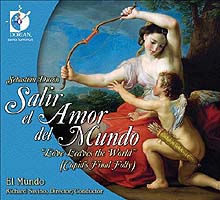

DORIAN
Sono Luminus
DSL-92107
Salir el Amor del Mundo
“Love Leaves the World”
(Cupid's Final Folly)
El Mundo
Richard Savino, Director

Spanish Vocal Music of the 17th & 18th centuries
Seventeenth-century Spain is a country of illusion and contradiction. Having been defeated by the British in 1588, Spain's rulers treaded a fine line between presenting an image of strength at home while dealing with severe blows to its empire. The dichotomy presented by this coexistence of fantasy and reality is nowhere more clearly demonstrated than in the Hapsburg court, ruled by Philip IV and immortalized through the paintings of Velázquez and the writings of Cervantes. The image presented is one of serenity and order while the reality is crisis and calamity. Such situations are the basis for great theatre. And in seventeenth century Madrid, the theatre flourished and the zarzuela was born.
Originally named after Philip IV's hunting retreat outside of Madrid, where some of the earliest productions took place, the zarzuela evolved at approximately the same time as did Italian opera, and shares a number of characteristics with its musical cousin. Both consist of numerous vocal solos, ensembles and choruses accompanied by basso continue. The instrumental forces were also similar to those that one might find in an opera by Peri or Monteverdi, two or three violins, an occasional cornetto and an elaborate continue section. More intriguingly, according to noted seventeenth-century Spanish scholar Louise Stein, these works were often performed with only female casts in order to satisfy the Madrid court's taste for “girlie shows,” featuring the actresses and singers who provided erotic servicing for their masculine needs.
…
Richard Savino
|
Personnel: Jennifer Ellis Kampani - Cupid (Amor) Karen Clark - Diana/Morpheus (Morreo) Nell Snaidas -Jupiter (Jove) Ann Moss - Apollo (Apolo)/Zagala (shepherd) Erica Schuller - Mars (Marte) Continuo: Richard Savino - (a) Baroque Guitar, (b) Theorbo John Schneiderman - (c) Baroque Guitar, (d) Archlute Daniel Zuluaga - (e) Baroque Guitar, (f) Theorbo Paul Shipper - (g) Baroque Guitar |
Soprano: Phoebe Jevtovich Bass: Paul Shipper Trumpet (clarin): Kathryn Adducci Harpsichord: Avi Stein Percussion: Kent Reed, Paul Shipper Viola da gamba: John Dornenburg, William Skeen (Luceros y Flores) Violone: John Dornenburg Violins: Adam LaMotte principal, Lisa Grodin, Aaron Westman Cello: William Skeen |
|
1) Seguidillas - José Nebra Salir el Amor del Mundo - Sebastian Durón {1660-1716) 2) ¡Muera Cupido! (Musica) (b,c,e) 3) Dorada luziente esfera (Diana, Musica) (a,c,f) 4) Y ya que en la selba (Apolo, Mars, Jupiter) (b,c,e) 5) ¿Qué importa que airada? (Musica, Zagala) (a,c,f) 6) Sosieguen descansen (Amor) (b,c,e) 7) Descanse el Amor (Morfeo) (b,d,e) 8) Del Amor los arpones rompa mi seño (Diana, Apolo, Mars, Jupiter) (a,c,e) 9) ¿Qué horror? (Amor) (a,c,f) 10) ¡Huye, huye cobarde! (Diana, Amor, Musica) (a,c,f) 11) De cuantos yerros forjó (Musica) (a,d,e) 12) Temores, ¿qué ruido es este? (Amor) (a,d,e) 13) Pues vibre la cuerda (Jupiter) (a,g) 14) ¿Dónde vas, cobarde? (Mars, Amor) (b,c,e) 15) ¡Eso no cobarde! (Apolo) (c, e) 16) ¡Ay de mi! (Amor) (b,c,e) 17) En el cóncavo profundo (Musica) (b,c,e) 18) Luceros y flores - Juan Hidalgo (1614 1685) - Jennifer Ellis Kampani, soprano 19) Ojos pues me dedeñais - José Marin (1619-1699) - Nell Snaidas, soprano 20) Xacara de Clarin - Juan Hidalgo (1614-1685) - Paul Shipper, bass 21) Ay que si - Juan Hidalgo (1614-1685) - Jennifer Ellis Kampani, soprano 22) Aquella sierra nevada -José Marin (1619-1699) - Erica Schuller, soprano 23) Fandango - Santiago de Murcia (l685-c.l732)/Anonymous/Antomo Soler (1729-1783) |
Dorian Recordings & Dorian Discovery
are distributed in Australia by Rockian Trading